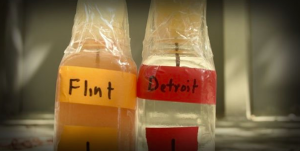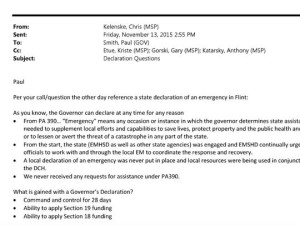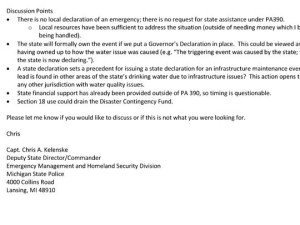Brandon Zirzow
Writing 205
4/25/16
Flint Water Crisis Leaves City Drowning in Corruption
With the current United States Government recently reaching nearly 20 trillion dollars in total accumulated debt, all evidence points to Government corruption and unorganized Government spending to blame for the lack of desperately needed funding for infrastructure repairs and updates. This lack of funding has led to a multitude of recent, potentially deadly infrastructural failures all across the United States.
The infrastructure all across the United States is in such poor condition numerous major cities, in the near future, are at serious risk for infrastructural failure. Every year, the American Society of Civil Engineers (ASCE) releases an Infrastructural Report Card establishing a specific letter grade for the current condition of different types of infrastructure found in the United States; we are currently failing, “The best grade the United States received was a B- for solid waste (solid trash removal), and the ratings just keep going down” (Kearly). As the infrastructure across the United States continues to rapidly decay the amount of necessary funding needed to fix the failing infrastructure will continue to increase, “…it is estimated that 3.6 trillion dollars will need to be invested by 2020 to fix everything” (Semerau). It is apparent that the current infrastructure in the United States is in desperate need of a serious uplift but how did the condition get so poor in the first place?
The current public infrastructure established by our government, paid for by our taxes, including roads, bridges, water facilities, and other public works are currently in need of desperate updating, renovation and funding, “Railways, ports, and public parks and recreation got Cs on the ASCE report card, while dams, drinking water, hazardous waste, levees, wastewater, aviation, inland waterways, and transit all got Ds. It’s completely terrifying to think about all the disasters that could result in any one of those categories” (Kearly). The current state of the public infrastructure, specifically the public drinking water facilities, established in the United States is ranked so poorly that there have been multiple infrastructural failures all across the country that have put hundreds of thousands of innocent people at risk.
One of the most recent potentially deadly infrastructural failures occurred in decaying Flint, Michigan, “In Flint, Michigan jobs have been scarce for years, but crime and foreclosures have been on the rise” (Clarke). The infrastructural problems in Flint have reached such a dangerous level to the extent where the combination of failing infrastructure and corrupt government officials have left thousands of innocent citizens at risk. With the multitude of recent infrastructural failures across the United States and corrupt government parties, the citizens of Flint are not the only ones at risk.
In Flint, Michigan the local government represented by Governor Rick Snyder, has recently been under heavy scrutiny and criticism for improperly carrying out a 2014 decision, to desperately try to save government funding, to switch the city of Flint’s main water supply from the treated Lake Huron to the untreated Flint River (“Flint Water Crisis”, 1). The decision to first switch the city’s water supply was in result of Flint having extreme financial issues and was an attempt to cut government spending in any way possible.
Why are we (the public) taking the risk when the corrupt government is to blame? The taxes we religiously pay to the government to have these simple public works fully functional and adequate are funding the private pockets of corrupt government officials.
When the physical change in water supply was conducted, necessary chemicals were not added to the water in order to prevent pipe corrosion in the existing water infrastructure. This attempt to save even more money by cutting necessary corners allowed a dangerous level of lead to leak into the city’s main water supply therefor contaminating the public drinking water of thousands of people, “Residents have for months—by cooking, cleaning, eating and bathing—exposed themselves and, more catastrophically, their children to lead, a well-known neurotoxin” (Clarke).The trace amount of lead levels in the public water supply have slowly been building up to a potentially dangerous level due to the slow response of Governor Rick Snyder, “This combination released lead anywhere from 25 to 1000 parts per billion into residents’ tap water. To put this in perspective, the Environmental Protection Agency allows only 15 parts per billion” (Semerau). Now, instead of paying a little bit more and carrying out the proper procedures the Flint government along with the residence of Flint are going to be paying to fix the corroded pipes for years to come.
When small, harmless trace amounts of lead were first detected in Flint’s water supply, months before the Flint government publicly announced there was a public health concern, governor Rick Snyder decided to hold off administrating a state of emergency and delay telling the public of these extreme health concerns. This delay was administered in hope of saving desperately needed government funding by allowing the problem to “fix itself” instead of directly addressing the problem and asking for much needed federal aid.
This delay in emergency response from Flint’s corrupt government officials escalated the problem from a slight water contamination issue to a full city water crisis, “We know that between 6,000 and 12,000 kids…have been exposed in this period of time to lead” (Kelller). Now thousands of Flint’s residence are suffering from extreme levels of lead poisoning and have little to no access to fresh water for bathing, cooking, and cleaning, “Compounding the initial error has been a failure at all levels of government to understand and respond to the crisis, in spite of efforts among a few individuals in government and health services to bring attention to the community’s unfolding unnatural disaster” (Clarke). If Governor Snyder and his team of environmental specialist put the safety of the residence first they would have taken proper precautions and alerted the public of potential harm immediately.
Personal emails containing information about the lead contamination between Flint’s top environmentalist and Governor Rick Snyder have been leaked to the public further confirming the rumor that Flint’s government officials knew of the possible lead contamination in the water months prior before publicly releasing a state of emergency, “Snyder acknowledged lead poisoning of Flint’s drinking water around Oct. 1, but faced strong criticism for not declaring a state of emergency in Flint and Genesee County until more than three months later, on Jan. 5” (Eager). This information was wrongful withheld from the residence of Flint and now they are the ones suffering because of it.
Today, Flint is relying on the support and funding of hundreds of outside, private donors such as sports stars, famous actors and actresses and a multitude of local companies, “As celebrities, corporations, and concerned citizens from around the country send bottled water and aid to Flint, Michigan to help the beleaguered community deal with the lead crisis, some residents are being shut out from receiving clean water” (“Seriously? Some Flint Residents…Don’t Have an ID”). Many more have pledged to continue to donate crates of fresh, uncontaminated water bottles, lead poisoning tests and other supplies directly to the people of Flint in order to help those directly affected by this deadly water contamination crisis.
Many people now claim that the slow response time to receive outside aid from the federal government and large support organizations was due to Flint’s mainly minority demographic. Many of the residence claim that this type of extreme infrastructural failure and decay would never happen in more affluent neighborhood and if this were to happen in another neighborhood, they believe the response would have been a lot swifter and more effective.
Flint’s failing infrastructure has been of public concern for quite some time and has just recently started to receive federal funding and attention due to the most recent fresh water crisis Flint is now recovering from. This issue in Flint brings up a bigger issue regarding large-scale Government corruption and failing infrastructure at all government levels across the United States (local, federal, community). The government’s first concern should always be preserving the safety of its people. This was not the case for Flint. Flint’s elected government officials deceived and lied to the public, the press, and the residence of Flint about the seriousness and extent of the water contamination in attempt to save corrupt government money.
At what point does the primary concern of government officials become protecting their own pockets and fixing their own self-made corrupt financial issues? It doesn’t. The primary concern of any (community/ local, state, federal) government first should be protecting and ensuring the safety of its citizens, and this was not the case for the residence of Flint.
Works Cited
- Clarke, Kevin. “Flint Water Crisis Draws National Response As Donations Pour In.” America 214.4 (2016): 10-11. OmniFile Full Text Mega (H.W. Wilson). Web. 23 Apr. 2016.
- Egan, Paul. “E-mails: Snyder Could Have Declared Flint Emergency Sooner.”Detroit Free Press. USA Today Netwprl, 29 Feb. 2016. Web. 23 Apr. 2016. (Primary Source)
- Direct emails, concerning lead contamination levels, between Governor Snyder’s political parties.
- Flint Water Crisis.” Congressional Digest 95.3 (2016): 10. OmniFile Full Text Mega (H.W. Wilson). Web. 23 Apr. 2016.
- Kearly, Kendyl. “United States Infrastructure Is Failing Dramatically, But No One Is Paying Attention.” Bustle. 20 June 2015. Web. 23 Apr. 2016.
- Keller, Andrew. “United Way Estimates Cost of Helping Children $100M.” – WNEM TV 5. Meredith Corporation, 18 Jan. 2016. Web. 23 Apr. 2016.
- Semerau, Kat. “Evaluate Failing Infrastructure’s Role in Flint Water Crisis.” University WireMar 07 2016. ProQuest. Web. 23 Apr. 2016 .
- “Seriously? Some Flint Residents Can’t Get Bottled Water Because They Don’t Have an ID.” Clutch Magazine RSS. Sutton New Media LLC. Web. 23 Apr. 2016.
Reflection Questions
1.) I titled this specific magazine article Flint Water Crisis Leaves City Drowning in Corruption, in order to capture the reader’s attention by playing with words to create a title that gives the reader enough understanding about what the paper is about but also keeps the reader guessing and wondering about exact argument and correlation between the two. The lede, in my article, establishes the main background information I utilized in my paper (the Flint Water Crisis) in order to establish my own, “bigger picture” argument about how government corruption and corporate greed influenced and escalated the Flint Water Crisis.
2.) The introductory section of my magazine article provides valuable background information and allows the reader to connect to the issue I established my argument on. This slow building of information allows the argument to develop and further invest itself with the outside source information I provided.
3.) In my magazine article I attempted to ease the reader into the argument by providing various types of evidence and background information before thoroughly explaining my specific argument.
4.) My New York Times magazine article establishes a clear track of clarity throughout the piece by utilizing and maximizing the relationship between the paragraph transitions. The transitions helped connect the information from the previous paragraph to the next paragraph and foreshadows the next advancement in my argument.
5.) Because of the specific audience of New York Times Magazines I was forced to provide enough background information on my given topic in order to properly inform the reader before establishing my argument.
6.) My preliminary research focused on the Flint Water Crisis ranging from the very beginning of the issue all the way to the current recovery. I then focused on developing an argument about how Flint’s corrupt government influenced and escalated the seriousness of the water contamination. To tie my argument into a recent argument of larger importance, I then related my specific argument to overall government corruption and failing infrastructure and the possibility of future catastrophes.
7.) In the Magazine Article itself I presented the readers with at least 6 outside sources and 1 primary source (direct emails between Flint’s Government Officials) along with 3 separate visual sources that all aid in the development of the argument throughout the article. The numerical representation exceeds the research expectations and I also fully utilized the specific outside sources to their maximum potential in aiding my argument.
8.) Before introducing any of my outside source material I clearly stated my own opinion and argument and then utilized the research and evidence from the outside sources to backup and further establish credibility of my own argument.
Specific Example: [Every year, the American Society of Civil Engineers (ASCE) releases an Infrastructural Report Card establishing a specific letter grade for the current condition of different types of infrastructure found in the United States; we are currently failing, “The best grade the United States received was a B- for solid waste (solid trash removal), and the ratings just keep going down” (Kearly).]
9.) In order to create a persuasive magazine I utilized various forms of ethos, logos, and pathos to connect to the reader on a multitude of levels.
Specific Example of Ethos: [Every year, the American Society of Civil Engineers (ASCE) releases an Infrastructural Report Card establishing a specific letter grade for the current condition of different types of infrastructure found in the United States; we are currently failing, “The best grade the United States received was a B- for solid waste (solid trash removal), and the ratings just keep going down”] (Kearly).
Specific Example of Logos: [“This combination released lead anywhere from 25 to 1000 parts per billion into residents’ tap water. To put this in perspective, the Environmental Protection Agency allows only 15 parts per billion” (Semerau).]
Specific Example of Pathos: [At what point does the primary concern of government officials become protecting their own pockets and fixing their own self-made corrupt financial issues? It doesn’t. The primary concern of any (community/ local, state, federal) government first should be protecting and ensuring the safety of its citizens, and this was not the case for the residence of Flint.]
10.) The visual aids I specifically selected to include in my magazine article further reinforced my argument in a multitude of ways that just using words would not have fully captured. The image of the extreme difference in coloration of the Flint water and the Detroit water is quite an overwhelming photo and clearly represents the grotesque water contamination issue. The images of the direct emails between Flint’s government officials also provides a different view on the seriousness of the corruption in Flint.
11.) My first preliminary drafts I used to compile all of my researched information and get my main arguments out by crudely combining quotes, written text, and visual aids from a variety of sources. My following drafts I focused on the clarity of the argument and overall flow of the paper. The comments from my peers focused on defining the clarity of my main argument and forced me to narrow my argument and relate the outside information back to my main argument.
12.) The hyperlinks I utilized in my article were specifically chosen to help establish further credibility and ethos from outside sources. The hyperlinks bring the reader to the generic site of specific organizations in order to provide valuable information on the credibility of the companies I drew research from.
13.) Between each stage of development I read over the entirety of my magazine article multiple times in my head, as well as, out loud in order to ensure that the writing was free of grammatical errors and maintained an even flow and voice throughout. I also purposefully varied the sentence length, sentence structure, and punctuation in order to create a unique reading experience for the reader that would not bore them.


